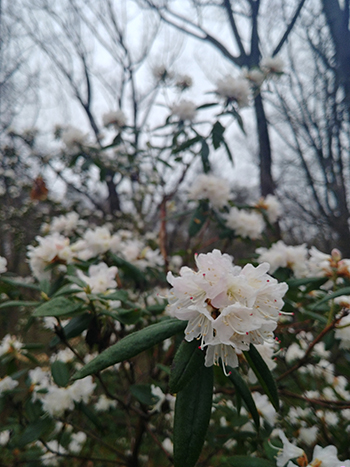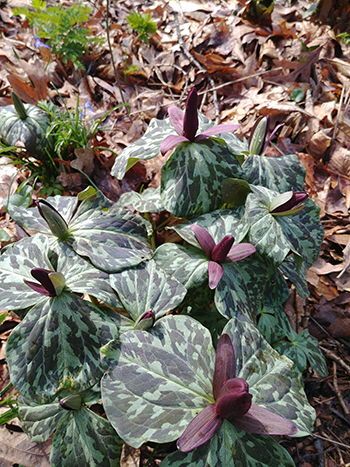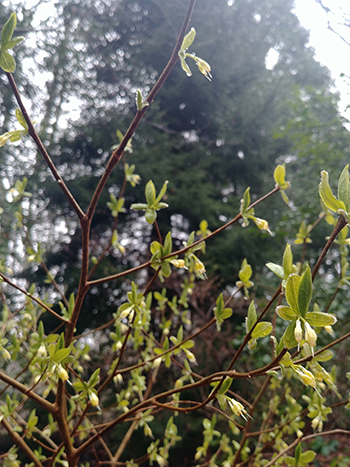
Plants of the Week: April 11

Rhododendron ‘Montchanin’ has burst onto the scene, the ethereal white blooms acting as an invitation into the Crum Woods. Rhododendron ‘Montchanin’ is a hybrid rhododendron with azalea-like qualities. The bell shaped blooms are translucent white with a hint of pink and the subtle, red-tipped pistil is the cherry on top! To me this plant is perfectly suited in the woodland setting above the amphitheater, matching the natural aesthetic. Unlike other azaleas, which often boast bright colors, the white blooms of R. ‘Montchanin’ stand out without looking gaudy, also befitting of the woodland spirit. Photo credit: R. Payne-Meyer

Another woodland dweller, Trillium sessile, commonly known as toadshade, is also putting on a show. This unique ephemeral gets a psychedelic appearance from the colorful and unpredictable spotting on the foliage. The silvery- blue- green- purple tones of the foliage present an unusual color palette that speaks to me, and it pairs well with the wine-red flowers. Equally as unique as the foliage, the flowers remain pursed (unlike the open blooms of T. erectum or T. flexipes) and lack a pedicel (stalk). T. sessile is a U.S. native with a broad range, stretching from the Great Lakes to Alabama, including Pennsylvania. Site in the dappled light of a wooded area for the greatest success and effect. You can find a number of T. sessile clumps in the Meetinghouse Woods. Photo credit: R. Payne-Meyer

Sticking to the woodland, Dirca palustris (commonly known as leatherwood) is putting on another unique, albeit subtle, floral display. This uncommon native may have understated qualities, but the simplicity is endearing to me. The slender, pendant flowers are a treat for those with a sharp eye; the yellowy green blooms appear just before the similarly colored new foliage in late March. Foliage is soft green in the growing season, a bit like Lindera benzoin, a common neighbor of D. palustris. The smooth goldish brown stems are quite ornamental, and also quite pliable. You can impress your friends by twisting the stems about; within reason they won’t snap! Requiring moist, rich soils, and some shade, D. palustris grows mostly in lowlands and along streambanks. To see D. palustris at the Arboretum, take the informal path above the Scott Outdoor Amphitheater near Clothier circle and look to the amphitheater side. Photo credit: R. Payne-Meyer





No Comments